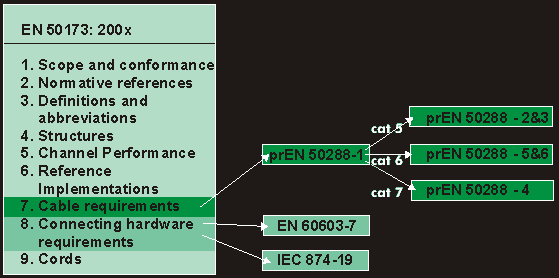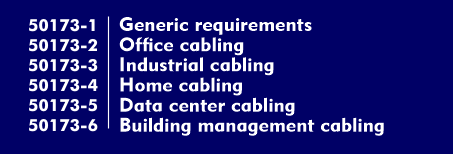EN 50173
In 1995, the European Committee for Electrotechnical Standardization( CENELEC) adopted the European standardEN 50173 for "Application-neutral cabling systems". The standard is largely based on the ISO/IEC11801 cabling standard and defines the topology and transmission characteristics for an open, i.e. vendor-neutral, in-house cabling system for telecommunications and information technology applications.
DIN EN 50173 deals with " application-neutral communication cable systems", their general requirements, the requirements for copper cables and optical fibers early the connection technology. The scope of application is defined as premises cabling, building c abling and floor c abling. The standard DIN EN 50173 was later extended by DIN EN 50174, DIN EN 50310 and DIN EN 50346, and subdivided into the following standards:
- DIN EN 50173-1: Information technology "Application-neutral communication cable system".
- DIN EN 50173-2: Information technology "Application-neutral communication cable system - office buildings".
- DIN EN 50173-3: Information technology "Application-neutral communication cable system - Industrial buildings".
- DIN EN 50173-4: Information technology "Application-neutral communication cable system - Residential buildings"
- DIN EN 50173-5: Information technology "Application-neutral communication cable system - Data centers".
- DIN EN 50173-6: Information technology "Application-neutral cabling system for building management".
The standard DIN EN 50173-1 deals with the generic requirements for "Application-neutral communication cable systems". This part deals with the hierarchical structure of the subsystems for the primary area, the secondary area and the tertiary area. It deals with the dimensioning of the and configuration of the subsystems as well as with limit values of the installation and transmission paths. This standard defines the data cables, their categories and link classes, as well as the OM classes, OS classes and OF classes of the optical fibers. Furthermore, it deals with the requirements for the connection components, such as the GG45 connector, the ARJ45 connector and the Tera connector.
These classes can be used to derive the performance requirements for the entire transmission link as well as the necessary components such as cables, connectors, data sockets and patch panels. Symmetrical copper cables( TP, UTP, STP) and fiber optic cables are approved as transmission media. The TP cables are adapted to the link classes and divided into so-called categories. Link classes E and F are realized by STP cables of categories 6( Cat 6) and 7 (Cat 7).
The DIN EN 50173-2 standard deals with the structure of the application-neutral communication cable system in office buildings. It deals with the dimensioning and performance of the transmission link as well as the performance requirements for the cables, connecting elements patch cords and patch panels.
The performance requirements of the EN 50173-3 standard correspond to those of standards -1 and -2, with the difference that EN 50173-3 refers to buildings used for industrial purposes. Otherwise, as in the other standards, it deals with structures, dimensioning and performance requirements for cables, fiber optic cables, connection elements and patch panels.
EN 50173-4 also deals with the structure, performance requirements and limits of cabling and interconnection components, but for communication cable systems in homes. EN 50173-4 is the standard for home cabling.


